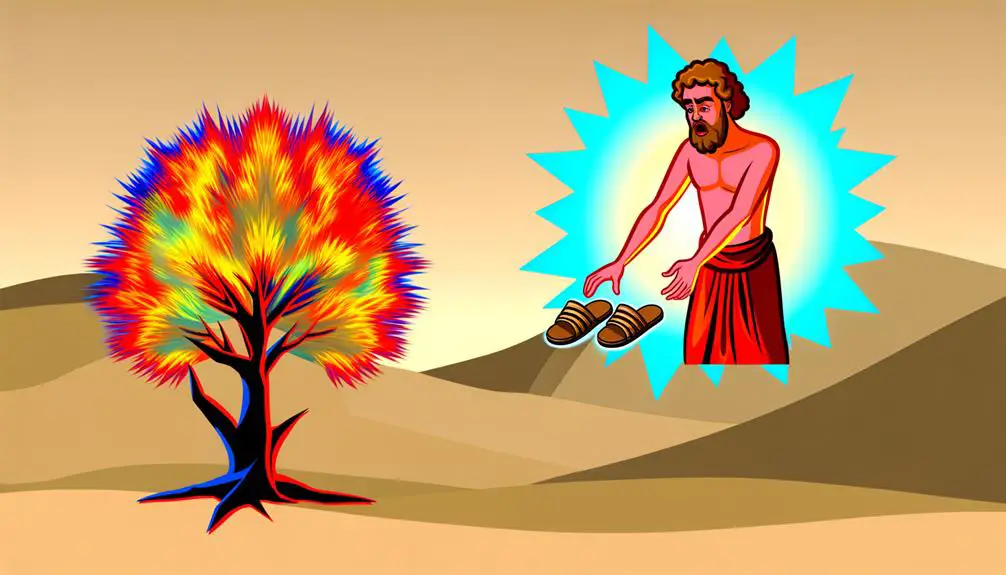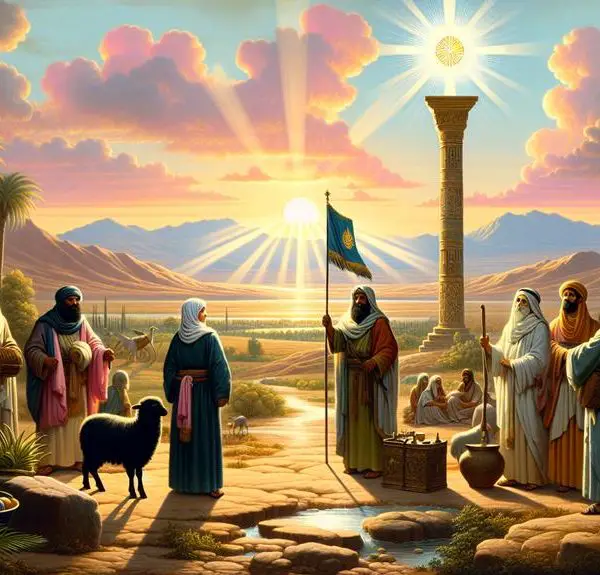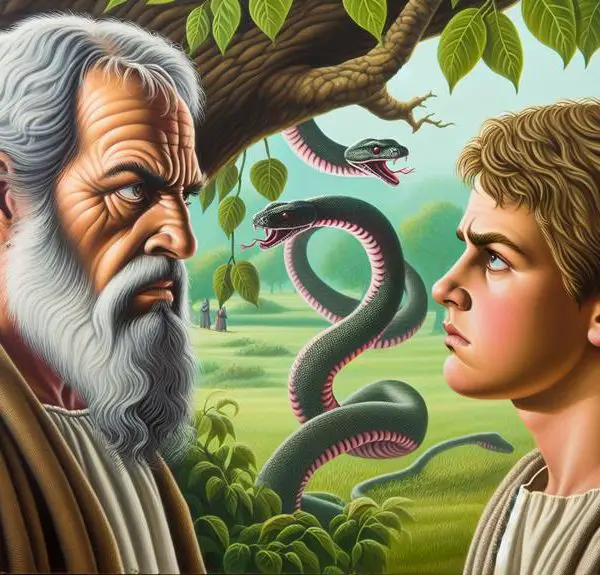Navigate the mystery of entheogens in biblical texts, where divine encounters may intertwine with ancient, mind-altering substances.

Entheogens in the Bible
In the ancient texts that many hold sacred, there are passages that, let's say, sparkle with an otherworldly sheen, suggesting encounters that go beyond the mundane.
As you explore these enigmatic references, from the Burning Bush Encounter to the Manna from Heaven, you'll find yourself questioning whether the prophets and seers were solely inspired by divine revelation, or if, perhaps, entheogens played a role in their visions.
The connections, like those with the Acacia Tree, beckon with the promise of unveiling deeper layers of spiritual understanding.
This journey into the biblical narrative might just change your perspective on the divine.
Key Takeaways
- Entheogens potentially played a role in pivotal biblical events, enhancing spiritual experiences and divine connections.
- The Acacia tree, with its psychoactive components, symbolizes resilience and might have contributed to mystical biblical encounters.
- Soma's ritual use in ancient scriptures underscores the significance of entheogens in spiritual communion and enlightenment.
- Biblical narratives incorporating entheogens challenge traditional interpretations, suggesting a deeper, symbolic relationship with the divine.
The Burning Bush Encounter

Analyzing the Burning Bush Encounter, one finds a pivotal moment in biblical narratives where Moses experiences a divine communication, challenging traditional interpretations of entheogens within religious texts. This event not only marks a significant turning point in Moses' leadership journey but also sets a precedent for understanding divine communication in the Judeo-Christian tradition.
You'll notice that the encounter at the burning bush is more than just an anomalous incident; it's a profound dialogue between the divine and the mortal. Here, Moses isn't merely a passive recipient of God's message but an active participant, questioning and engaging with the voice from the bush. This interaction underscores the complexity of Moses' leadership, as it evolves through direct communication with the divine. It's a moment that emphasizes responsiveness and responsibility in leadership roles, guided by a higher calling.
Furthermore, this narrative challenges you to reconsider the role of entheogens in religious experiences. While some argue that such encounters could be attributed to natural psychoactive substances, the burning bush encounter transcends simplistic explanations. It illustrates a unique form of divine communication that's intentional, direct, and transformative.
Manna From Heaven Explained

How does the biblical narrative of manna from heaven challenge our understanding of divine provision and its implications for faith and sustenance? This tale, deeply woven into the fabric of Judeo-Christian belief, invites you to ponder the intersection of the miraculous with the everyday and the divine's intimate involvement in human affairs. Manna, as described, wasn't merely food; it was a testament to divine provision, requiring a trust in the unseen and an acceptance of sustenance beyond conventional means.
Historical interpretations offer a spectrum of perspectives, ranging from manna being a natural substance with extraordinary timing to a purely miraculous occurrence devoid of any natural explanation. These interpretations serve not only to bridge the gap between faith and rationality but also to challenge the very notions of what constitutes nourishment, both physical and spiritual.
Consider the following to deepen your emotional engagement with the narrative:
- The daily collection of manna required absolute faith in continuous divine provision, a reminder of the need for daily dependence on the divine.
- The prohibition against hoarding manna underscores a lesson in trust and the relinquishment of control, encouraging a communal reliance over individual resourcefulness.
- The eventual cessation of manna upon entering the Promised Land signifies a shift in the way divine provision is experienced, suggesting a maturation of faith and a new phase in the relationship between the divine and the faithful.
Through these lenses, the story of manna from heaven transcends its historical interpretations to speak directly to the heart of faith, challenging you to consider the ways in which divine provision manifests in your own life.
Visions in the Book of Ezekiel

In the Book of Ezekiel, the prophet's extraordinary visions offer a complex glimpse into the divine realm, challenging believers to consider the depth and breadth of spiritual experiences. You're drawn into a narrative where Ezekiel's chariot, a vivid symbol of divine presence and mobility, stands out as a central element. This imagery isn't just fantastical; it's steeped in prophetic symbolism, inviting you to delve deeper into its meanings and implications.
Ezekiel's encounters are rich with symbols that resonate with ancient traditions of mysticism and prophecy. The chariot, with its intricate details and celestial beings, serves not only as a vehicle for divine revelation but also as a metaphor for the complexity and majesty of the divine order. It's a representation that transcends the immediate narrative, reaching into the very fabric of spiritual understanding.
As you explore these visions, you're encouraged to interpret the layers of meaning behind Ezekiel's experiences. The prophetic symbolism found throughout these passages isn't merely for intrigue; it's a call to introspection and spiritual awakening. The vividness of the visions, coupled with the depth of symbolic language, provides a fertile ground for theological exploration.
Ezekiel's experiences challenge you to question and expand your understanding of divine interaction with humanity. The prophetic symbolism embedded within these visions serves as a bridge between the earthly and the divine, inviting you to consider the multifaceted ways in which the sacred manifests in the world. Through Ezekiel's eyes, you're given a lens to view the divine realm, a realm that's both awe-inspiring and profoundly mysterious.
The Acacia Tree Connection

Shifting our focus to the Acacia tree, you'll find its significance deeply embedded in biblical narratives, offering another layer to our understanding of spiritual symbolism. Acacia trees aren't only prevalent in the landscapes of the Bible but are also imbued with profound spiritual and symbolic meanings. They're often noted for their durability and the incorruptible wood they produce, qualities that make them emblematic of immortality and resilience in the face of spiritual adversity. Furthermore, the Acacia tree holds a fascination for scholars and theologians alike due to its psychoactive components, which some speculate may have played a role in the profound mystical experiences recorded in biblical texts.
Here are three key points to consider about Acacia symbolism and its implications:
- The Sacred Construction: Acacia wood was chosen for the construction of the Ark of the Covenant and the Tabernacle, signifying its purity, strength, and divine approval.
- Symbol of Endurance: In biblical symbolism, the Acacia tree represents endurance and immortality, qualities that echo the eternal covenant between God and His people.
- Gateway to the Divine: The psychoactive components of Acacia may suggest its use as a medium for spiritual communication and enlightenment, offering a bridge between the earthly and the divine.
These elements collectively paint a picture of the Acacia tree as not merely a plant of practical utility but as a significant spiritual symbol, potentially offering insights into the mystical experiences of biblical figures and their profound encounters with the divine.
Soma in Ancient Scripture

ARTICLE TITLE: Entheogens in the Bible
PREVIOUS SUBTOPIC: 'The Acacia Tree Connection'
CURRENT SUBTOPIC: 'Soma in Ancient Scripture'
Turning our attention to the concept of Soma in ancient scripture, it's essential to explore its mystical attributes and historical significance within religious texts. Soma holds a pivotal role, not just as a plant or concoction but as a divine embodiment that connects humans to the spiritual realm. Its ritual significance is profound, offering insights into how ancient civilizations sought communion with the divine.
Aspect |
Insight |
|---|---|
Ritual Significance |
Soma was central to rites and ceremonies, symbolizing purification and connection to the divine. |
Cultural Interpretations |
Interpretations of Soma vary, reflecting diverse theological and cosmological views. |
Diving deeper, you'll find that Soma's mention in sacred texts isn't merely literal. It often symbolizes a broader, more intricate tapestry of spiritual nourishment and enlightenment. Scholars and theologians debate its exact nature, yet the consensus leans towards Soma being both a physical substance and a metaphysical concept. This duality enriches its cultural interpretations, making it a fascinating subject for those studying ancient religious practices.
The ritual significance of Soma cannot be overstated. It's not just about the act of consumption but about the ritualistic preparation and offering, which in itself was a form of worship and devotion. Such practices highlight the profound respect and reverence ancient societies had for the natural world and its spiritual potency.
Frequently Asked Questions
How Do Current Religious Leaders Interpret References to Entheogens in the Bible?
You're delving into how religious leaders today interpret ancient texts, especially considering entheogen definitions and modern skepticism. They often approach these texts with caution, balancing traditional beliefs with contemporary understanding.
While some may see references to mind-altering substances as metaphorical or spiritual rather than literal, others might be more open to the idea that such practices were part of early religious experiences.
This nuanced perspective respects historical context and evolving interpretations.
What Historical Evidence Exists Outside of the Bible to Support the Use of Entheogens in Ancient Religious Practices?
You're delving into a fascinating topic: the historical evidence supporting the use of entheogens in ancient religious practices.
Ancient artifacts and ritualistic parallels provide compelling proof. You'll find that archaeological discoveries, including ritual vessels and frescoes, hint at these substances' roles in spiritual ceremonies.
Scholars analyze these findings meticulously, respecting the cultures involved while shedding light on how ancient societies sought transcendence, possibly through entheogens, in their quest for spiritual enlightenment.
Are There Any Modern Religious Movements That Openly Incorporate the Use of Entheogens as Part of Their Spiritual Practice?
Yes, there are modern religious movements that openly use entheogens in their spiritual practices.
You'll find these groups face legal challenges, as their practices intersect with drug laws.
However, scientific research supports the therapeutic and spiritual benefits of entheogens, contributing to a growing acceptance.
Movements like Santo Daime and the Native American Church are examples, navigating legal systems to practice their beliefs while contributing to the discourse on religious freedom and entheogen use.
How Do Entheogens Fit Within the Broader Context of Biblical Dietary Laws and Restrictions?
When you examine biblical dietary laws, you'll find they're not just about health but also ceremonial purity and dietary symbolism.
Interestingly, 90% of these regulations emphasize separation and holiness.
Entheogens, or psychoactive substances, fall into a unique category. They're not explicitly mentioned, yet their potential use hinges on interpretations of purity and symbolic acts within a spiritual context.
This nuanced approach highlights the complexity of integrating such substances into traditional religious frameworks.
What Are the Ethical Considerations Surrounding the Interpretation of Sacred Texts to Suggest the Use of Psychoactive Substances in Religious Contexts?
You're venturing into complex territory when interpreting sacred texts to endorse psychoactive substances in religious practices. It's crucial to weigh the legal implications and practice cultural sensitivity.
Misinterpretation can lead to ethical dilemmas, straining both legal boundaries and cultural respect. Thus, your analysis must be thorough and respectful, ensuring that your conclusions don't inadvertently harm or misrepresent the traditions and laws of the communities involved.
Conclusion
Isn't it fascinating how the ancient texts seem to whisper secrets of the past, particularly about entheogens?
Your journey through the biblical narratives, from the burning bush to manna and beyond, reveals a profound connection between spirituality and psychoactive substances.
This exploration not only uncovers the possible use of entheogens in biblical times but also invites us to reconsider our understanding of sacred experiences.
In this light, the ancient scriptures offer a richer, more complex tapestry of human-divine interaction than previously imagined.



Sign up